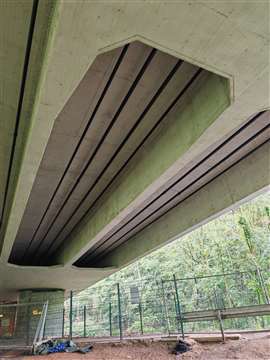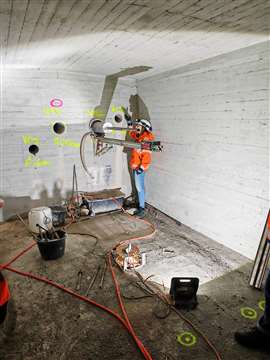A critical moment for Germany’s bridges
05 July 2024
 The 1960s Theodor Heuss bridge in Essen, Germany, is undergoing external post-tensioning to extend its lifespan by 15 years.
The 1960s Theodor Heuss bridge in Essen, Germany, is undergoing external post-tensioning to extend its lifespan by 15 years.
As Europe’s largest economy, Germany is renowned for having first-class infrastructure but even in one of the region’s wealthiest countries, the bridges are crumbling.
Last year, Construction Europe learned how around 10% of Europe’s two million bridges are in a potentially dangerous condition.
High-profile collapses like the Morandi Bridge disaster in Genoa, Italy, which killed 43 people when it collapsed in a 2018 storm are a reminder of what’s at stake.
 Steel tendons running longitudinally under one of the bridge’s two superstructures.
Steel tendons running longitudinally under one of the bridge’s two superstructures.
But the future of Germany’s bridges now enters a critical moment, after several German construction associations* including the Zentralverband Deutsches Baugewerbe (ZDB) and Hauptverband Deutsche Bauindustrie (HDB) last month issued an emergency statement warning that plans to cut the federal budget would be “fatal” to Germany’s infrastructure.
Over 4,000 Germany motorway bridges need urgent renovation or reconstruction.
Two years ago, Germany’s federal transport minister Volker Wissing promised at a national bridge summit that the government would carry out 400 bridge construction projects a year from 2026 to clear the renovation backlog within 10 years.
Much has changed since then and the group of German construction associations joined forces to warn, “We are a long way from the 400 bridges per year. In addition, an increasing number of tenders have been cancelled in recent weeks due to a lack of funds and the construction programme of Autobahn GmbH [the German body responsible for planning, constructing and financing motorways and trunk roads] is stretched overall.”
In fact, Autobahn’s budget is to be cut by 20% from €6.2 billion (US$6.6 billion) a year to €4.9 billion (US$5.3 billion), according to the group of associations. They warned against cutting funding for motorway construction and called for addition investment of €1 billion (US$1.1 billion) a year to get the bridge modernisation programme up and running. “This negligent investment policy will lead to further bridges being closed and the road network falling into further disrepair,” they warned.
Adding 15 years to a bridge’s life
It was against this backdrop that Construction Europe and Construction Briefing joined a group of representatives from the European Construction Industry Federation (FIEC) to witness progress on a bridge rehabilitation project in Essen, Germany, that illustrates the challenges the country faces.
 Autobahn’s Janina Baumbach discusses plans for the external post-tensioning project.
Autobahn’s Janina Baumbach discusses plans for the external post-tensioning project.
At first sight, the Theodor Heuss bridge, a pre-stressed concrete beam road bridge built in 1969 that carries the A44 motorway across the river Ruhr and an adjoining railway line, looks in good condition.
But monitoring of the bridge, which is made up of two superstructures each carrying four lanes of traffic, by Autobahn in 2017 revealed that it was in urgent need of rehabilitation to extend its life. In fact, Autobahn’s building inspectors gave the southern superstructure in the direction of Velbert a condition grade of 2.5 (in a scoring system that assesses durability, stability and traffic safety, where 1 is the highest score and 4 the lowest). The northern superstructure in the direction of Essen scored 2.3. That meant Autobahn had to enforce traffic restrictions including an overtaking ban for trucks and a minimum of 70m between heavy goods vehicles until it could calculate how to deliver an external post-tensioning system.
Subsequently, contractor Eurovia has been appointed to carry out the €4.6 million project (US$4.9 million), adding high-strength steel tendons both longitudinally and cross-sectionally to the bridge.
By doing so, Autobahn hopes to extend its life until 2037, deferring an estimated cost of at least €30-40 million (US$32.2-$43 million) for its wholesale demolition and replacement.
“This is a very high-density area and the infrastructure was built after the second world war, in the 1950s, 1960s, and 1970s,” says Tobias Fischer, Autobahn’s head of construction and maintenance in the region.
 Installation of the steel tendons involves core drilling through up to three metres of concrete within the bridge.
Installation of the steel tendons involves core drilling through up to three metres of concrete within the bridge.
“We have the same issues everywhere – the bridge is getting older, the load is higher because we have much more traffic. Therefore we have to do something with our bridges.”
In this region of Germany alone, Fischer and his Autobahn colleagues are responsible for 600 bridges, from the smallest structures to those up to 2.3km long. “We cannot do everything at the same time, so it is important to maintain and reinforce all bridges to withstand the new loads,” he says.
Janina Baumbach, who is in charge of the project for Autobahn, explains how installation of the tendon system from BBV Systems involves core drilling through cross beams that are up to three metres thick, at the same time as carefully avoiding the existing tendon layers.
A total of about 10km worth of tendons are being installed in the bridge. The main tendons carry 2.4 mega newtons (MN) of pre-load force, anchored by eight or nine concrete anchor blocks per superstructure. The additional tendons carry 3.2 MN of pre-load force with the load introduced via anchor plates in the crossbeams. There are 16 anchor plates on one of the superstructures and 18 on the other.
Crumbling bridges ‘a challenge that’s only going to grow’
Witnessing the works was Christian Tridon, founder of the Eurobridge conference, an annual event held in Brussels.
Tridon warned that the challenge of repairing and replacing bridges not just in Germany but in Europe as a whole is only set to grow.
 Anchor points have been installed at positions throughout the bridge for the steel tendon system.
Anchor points have been installed at positions throughout the bridge for the steel tendon system.
“Bridges are an essential element of communication but the vast majority of road bridges in Europe date from the 1950s. Today, that makes them more than 70 years old. That means you have problems with degradation and deficiency and that requires regular maintenance but this has not been done,” he says.
“A young engineer leaving school today is going to undertake an awful lot of repair work – more so than construction work.”
Given the scale of the work required and the constraints on funding, Tridon who is based in France, welcomed the opportunity to see how bridge rehabilitation projects are being approached in Germany.
“It prompted me to reflect on two or three things. There were some things that interested me that we don’t do in France but that the Germans do. It’s a good idea for us to bring together our collective experience and competencies and put it all on the table,” he says.
“There’s not currently any organisation within Europe that allows the exchange [of ideas and best practice] and it’s that that I would like to do via the Eurobridge project and with the assistance of FIEC. It’s all about reflecting together on this challenge, which is only going to grow in the coming years.”
At the next Eurobridge conference, taking place in Brussels, Belgium, on 11 April 2025, Tridon also hopes to look to how US construction companies and their clients are approaching the problem, which in his estimation is at least as serious as in Europe.
German construction associations await an answer
Back in Germany, the country’s own Federal Ministry of Transport and Digital Infrastructure (BMDV) estimates that 1,000 motorway bridge structures are in an “inadequate structural condition”, according to recent inspections.
 The Theodor Heuss bridge in Essen, Germany, runs over the river Ruhr and a railway line.
The Theodor Heuss bridge in Essen, Germany, runs over the river Ruhr and a railway line.
In their joint emergency statement, Germany’s construction associations warned, “The load-bearing capacity and thus the functionality is severely impaired in a large number of bridges. If the bridge construction programme is not implemented (as announced by the federal government) the associations predict further bridge failures that would paralyse traffic for years.”
They also warned that construction companies that have geared up for bridge works that the federal government had originally committed to but has since put on hold face financial losses.
So far, there has been no official response to the associations’ warnings from Germany’s government. That’s because secretive negotiations over budgets continue and are likely to last the rest of this month.
Summing up what is at stake, Tim Oliver Müller, CEO of Bauindustrie told Construction Europe, “Germany is heading for a massive problem with its road and bridge infrastructure. With the planned budget cuts of 20%, more than 100 construction projects across Germany, including extremely important bridges, would have to be postponed indefinitely. The federal government needs to decide either it makes more investment funds available for 2024 and the following year, or it must expect traffic to be severely disrupted.”
* The consortium of associations also included: the body representing medium-sized construction companies, the BVMB; the German Association of Consulting Engineers (VBI); the German Asphalt Paving Association (DAV); the Pro Mobilität alliance to promote efficient infrastructure; the Quality Association for Steel Guardrails (Gütegemeinschaft Stahlschutzplanken); the German Association for Noise Protection on Traffic Routes (DVLV); and transport and logistics associations ADAC, BGL, DSLV und BWVL.
CONNECT WITH THE TEAM





